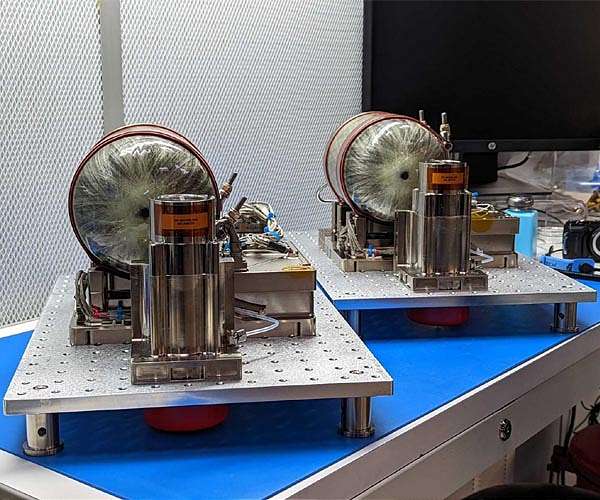
Phase Four unveils game changing engine for LEO constellations (Image Credit: Space Daily)
Phase Four, the creator of the radio-frequency thruster for satellite propulsion, reports that it will expand its Maxwell turn-key plasma propulsion line and offer satellite manufacturers an industry-first high performance engine using an inexpensive, domestically sourced iodine-based propellant. Max-V leverages the Maxwell Block 2 engine’s innovative architecture and builds on the radio-frequency thruster’s propellant agnostic capabilities.
“Legacy electric propulsion systems are tied to noble gases like xenon and krypton,” said Phase Four CEO, Beau Jarvis. “These noble gases, while high performing, are largely sourced outside of the United States in China, Russia and Ukraine. The US has no real control over this supply chain, which is subject to high price volatility and recent severe supply issues.”
Phase Four board member, former NASA Administrator Jim Bridenstine observed, “This year we’ve seen xenon prices spike to over $30,000 per kilogram. This is cost prohibitive for both commercial and government satellite constellations in low Earth orbit.” Bridenstine continued, “The US is the world’s third largest iodine producer, and my home state of Oklahoma leads the way in domestic production. With Max-V, we can ensure a fully domestic supply chain and readily accessible low cost propellant.”
Phase Four’s Maxwell Block 1 engine gained flight heritage in early 2021. Maxwell Block 2 engine deliveries began earlier this year. With double digit commercial flight units delivered, the company is now focusing on its Max-V development effort.
Maxwell’s new chassis-style design enables rapid on-ramping of improvements in the core areas of the thruster, power electronics and propellant subsystems. This architecture is streamlining the Max-V development process as is the company’s significant experience with iodine-based propellants through its recent U.S. Air Force AFWERX award.
“Maxwell’s new modular chassis architecture enables us to introduce improved capabilities within the same form factor,” said Phase Four CTO, Umair Siddiqui. “Using an iodine-based propellant instead of a noble gas propellant stored at very high pressure provides a number of benefits to our customers. Iodine stores as a solid without high pressure valves or vessels, which means we can deliver fully fueled engines directly to our customers.”
Siddiqui continued, “Iodine also stores about three times more densely than xenon, which means our propulsion systems will offer much higher total impulse in the same unit volume as legacy electric propulsion systems.”
“We’ve always said that Phase Four delivers game changing propulsion systems, and Max-V will do just that,” said Phase Four CEO, Beau Jarvis. “We are building a product that will dramatically lower costs and extend operational lifetimes of small satellites in low Earth orbit and provide significantly higher total impulse for missions beyond LEO.”
Max-V is anticipated to be available for order in the second half of 2023. The system is designed to operate from 200 Watts to 1.5 kiloWatts, and achieve 50 mN thrust, over 1,200 s Isp and deliver over 100 kNs total impulse. Max-V’s iodine-based propellant will cost under $400 per kilogram and be incorporated in the purchase price. Max-V’s form factor is similar to Phase Four’s current Maxwell Block 2 engine. The system will ship fully fueled, ready for installation and will require no ground fueling operations prior to launch.
Phase Four is a disruptive provider of next generation electric propulsion (EP) solutions for small satellites. The company was founded in 2015 to address the demands of the rapid proliferation of satellite constellations and to accelerate the advancement of its radio-frequency thruster (RFT).
The Phase Four RFT represents a revolutionary new architecture that realizes lower cost, mass-manufacturability, miniaturized power electronics, and propellant agnosticism over incumbent technologies, without compromising performance. In 2021 Phase Four’s Maxwell turn-key propulsion system achieved flight heritage and is now being regularly utilized by small satellite operators.
Related Links
Phase Four
The latest information about the Commercial Satellite Industry
|
|
Tweet |
|
|
|
We need your help. The SpaceDaily news network continues to grow but revenues have never been harder to maintain. With the rise of Ad Blockers, and Facebook – our traditional revenue sources via quality network advertising continues to decline. And unlike so many other news sites, we don’t have a paywall – with those annoying usernames and passwords. Our news coverage takes time and effort to publish 365 days a year. If you find our news sites informative and useful then please consider becoming a regular supporter or for now make a one off contribution. |
||
|
SpaceDaily Monthly Supporter $5+ Billed Monthly |
SpaceDaily Contributor $5 Billed Once credit card or paypal |
|
Amazon’s Project Kuiper will now launch with ULA rockets
Washington DC (UPI) Oct 13, 2021
Amazon announced on Wednesday that Project Kuiper will launch prototype satellites on the first flight of United Launch Alliance’s (ULA) new Vulcan Centaur rocket in 2023.
The goal of Project Kuiper is to launch a series of 3,236 satellites into low earth orbit to provide broadband access to areas of the globe that lack high-speed internet.
“We couldn’t be more excited to join the first launch of ULA’s Vulcan Centaur. We’ve already secured 38 Kuiper launches on Vulcan, using the same lau … read more









